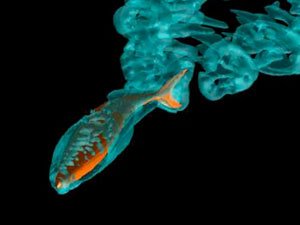Going with the flow

Researchers find first evidence that water movements can mold fish bodies and swimming styles
By Deane Morrison
The water movements generated by fish as they swim could have a hand in shaping the form of their bodies and their swimming style.
So conclude researchers at the University of Minnesota's St. Anthony Falls Laboratory (SAFL), who have just found the first evidence that the way water moves over a fish, and at what velocity, could be an evolutionary force.
The study, published in the Journal of Experimental Biology, aimed to find what shapes and swimming motions were most efficient—that is, used energy most judiciously—at different speeds.
That knowledge could guide the design of aquatic robots, which someday may be built to retrieve samples from toxic waste pools or the ocean depths; spy on unfriendly ships; or even deliver drugs via the human bloodstream.
Also, other researchers can adapt the methods to study how fluid environments shape other organisms, including birds and insects.
Eels and their eerie efficiency
The research began as a way to understand why fish are so different in shape and swimming styles, and how those traits might allow some to perform amazing feats, says SAFL director and civil engineering professor Fotis Sotiropoulos, co-author on the paper.
For instance, eels, which are shaped and swim similarly to lamprey, are neither large nor particularly fast. Yet some migrate a good 3,000 miles, from the coastal waters of Europe to the Sargasso Sea, to spawn.
"How can they swim efficiently enough to do this with limited energy reserves?" Sotiropoulos asked.
Patterns of water movements—hydrodynamics—generated by organisms were long suspected of having the power to steer the evolution of creatures that live in fluid environments. But this influence is hard to study in real fish, which have a habit of not performing on demand.
Hydrodynamic duo
Patterns of water movements—hydrodynamics—generated by organisms were long suspected of having the power to steer the evolution of creatures that live in fluid environments. But this influence is hard to study in real fish, which have a habit of not performing on demand.
Therefore, postdoctoral researcher Iman Borazjani and Sotiropoulos turned to their computers. They simulated two fish with the sleek, powerful shape of a mackerel: one that swam like a real mackerel and one that moved with the wriggling motion of an eel. They also made two lampreys, one that wriggled like a real lamprey and one that beat its tail like a mackerel.
The researchers threw all four virtual fish into a virtual tank and tested their performance in two simulated environments. In one, the water movements over the fishes' bodies were similar to those generated by the slower swimming of a lamprey, and in the other they resembled those produced by the speedier mackerel.
The results showed that all fish swam more efficiently if they had the body form or swimming style appropriate to the speed. That is, at slower speeds, fish shaped and moving like lamprey could swim most efficiently; for a real fish, that would mean being the last one to tire out. Likewise, swimming at mackerel speeds was most efficient for fish shaped and moving like mackerel.
"From these experiments we can deduce that real mackerel and eels have evolved in response to the hydrodynamic environments they generate and become adapted to them," says Sotiropoulos.
So how come slowpokes like goldfish don't look like lamprey?
"Our studies were only for fish swimming steadily for long periods. Both mackerel and lamprey migrate over long distances," says Borazjani. "Other fish, such as goldfish, may have been shaped by the need for other traits, such as maneuverability."
The study was funded by the National Center for Earth-surface Dynamics.
